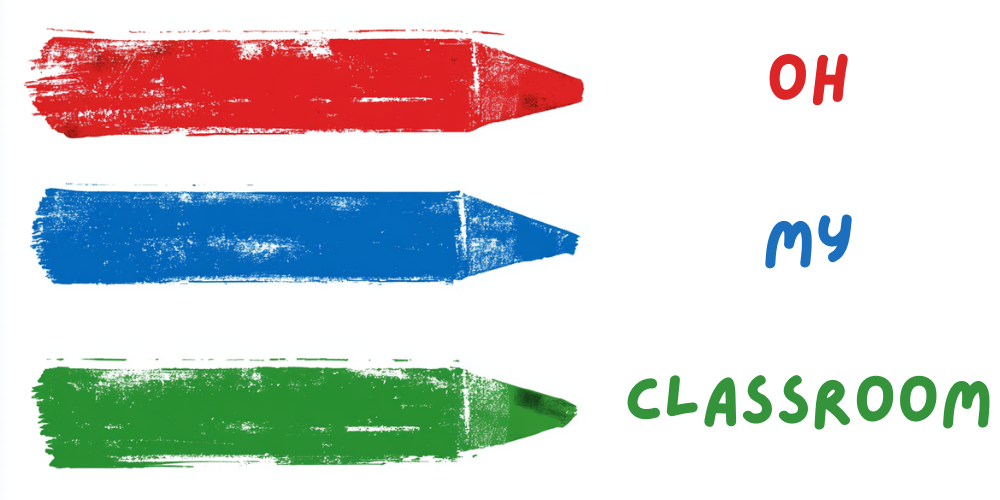Frogs are fascinating creatures that capture the imagination of preschoolers. Their vibrant colors, unique shapes, and playful nature make them a popular theme for crafts.
Engaging in frog-themed crafts not only sparks creativity but also provides an opportunity for young children to learn about the natural world around them.
Whether it’s for a rainy day activity or a classroom project, here are Easy Frog Crafts for Preschoolers.
Paper Plate Frog:

One of the simplest and most versatile frog crafts for preschoolers is the paper plate frog. Start by providing each child with a paper plate and some green paint. Instruct them to paint the entire plate green and let it dry. Once dry, help the children cut out two large circles for the eyes from white paper and smaller circles for the pupils from black paper. They can glue their eyes onto the plate and draw a smiling mouth with a marker. To complete the craft, cut out four legs from green construction paper and attach them to the bottom of the plate. The preschoolers will be thrilled to see their paper plate frogs come to life, and they can even hop them around the room during playtime.
Frog Puppets:

Encourage creativity and imaginative play with frog puppets. Provide each child with a green paper bag and an assortment of craft materials like googly eyes, foam shapes, and colored paper. Help them cut out a long, curved tongue from red construction paper and glue it inside the bag’s opening. They can then decorate the bag with eyes, a mouth, and any other frog-like features they desire. Once the puppets are ready, the preschoolers can put their hands inside the bags and bring their frog characters to life. They can use the puppets to engage in storytelling, sing songs, or even put on a puppet show for their friends and family.
Related: 20 Fun Dinosaur Preschool Activities
Lily Pad Art:
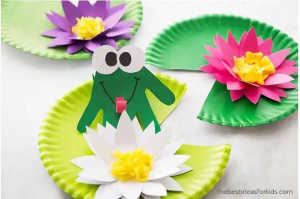
Combine art and nature with a fun lily pad craft. Take the preschoolers on a nature walk to collect large leaves that resemble lily pads. Back in the classroom, provide each child with green construction paper or cardstock and a leaf. Instruct them to place the leaf on the paper and use green crayons or markers to trace around it, creating the shape of a lily pad. After removing the leaf, they can further decorate their lily pads with additional drawings, such as water ripples or frogs. This activity not only allows children to explore the textures and shapes found in nature but also introduces them to the concept of camouflage as they create their frog’s hiding spot.
Frog Life Cycle Collage:

Teach preschoolers about the fascinating life cycle of frogs through a collage activity. Prepare a variety of craft materials, such as green construction paper, tissue paper, googly eyes, and cotton balls. Provide each child with a large sheet of blue paper as the background. Start by discussing the different stages of a frog’s life, from eggs to tadpoles, then froglets, and finally adult frogs. Help the children cut out and assemble the various stages using craft materials. They can glue the eggs near the water’s surface, the tadpoles in the water, and so on. Encourage them to use their creativity to represent each stage of the life cycle. The resulting collages will not only showcase their artistic abilities but also reinforce their understanding of frog development.
Related: 20 Exciting Turn Taking Activities for Toddlers
Jumping Frog Game:
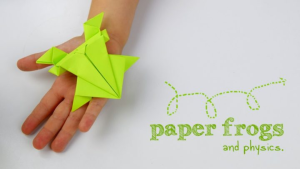
Combine craft and play with a jumping frog game. Provide each child with a square piece of green construction paper and help them fold it into a triangle. Next, guide them in folding the triangle into smaller triangles, resembling a paper frog. With the frog-shaped paper in hand, instruct the preschoolers to place their thumbs on the folded edge and press down firmly, then release to make the frog jump. They can decorate their frogs with eyes, a mouth, and other features using markers or stickers. Set up a designated hopping area and encourage the children to have a friendly competition, seeing whose frog can jump the farthest. This interactive craft is sure to keep preschoolers entertained while enhancing their hand-eye coordination and fine motor skills.
Frog Handprint Art:

Preschoolers will enjoy creating frog handprint art, which also serves as a delightful keepsake. Provide each child with a sheet of white paper and non-toxic green paint. Instruct them to dip their hand in the paint and carefully press it onto the paper, with fingers spread wide to resemble the frog’s body and the thumb pointing upwards as the head. Once the handprint is dry, they can add details like eyes, a mouth, and legs using markers or googly eyes. Encourage them to get creative with additional decorations such as a crown or a tongue. This activity allows children to explore their sense of touch and create personalized frog artwork.
Frog Binoculars:

Let preschoolers embark on a frog-watching adventure with their very own frog binoculars. Provide each child with two empty toilet paper rolls and assist them in decorating the rolls with green paper or paint to resemble frogs. They can add eyes, a mouth, and any other frog features using markers, colored paper, or craft foam. Once the binoculars are decorated, help them attach the rolls together with tape or glue. The preschoolers can then use their frog binoculars to observe their surroundings, search for frogs, or engage in imaginative play. This activity encourages curiosity and observation skills while fostering creativity.
Frog Crown:

Preschoolers can transform into hopping frogs with a fun and easy frog crown craft. Start by measuring a strip of green construction paper or cardstock to fit around each child’s head comfortably. Help them cut out crown shapes from the green paper, with zigzag edges resembling the frog’s back. They can then decorate their crowns with eyes, a mouth, and other frog-like features using markers, stickers, or foam shapes. Assist the children in attaching the crown shapes to the measured strip, forming a frog crown. The preschoolers will delight in wearing their frog crowns during pretend play or a frog-themed celebration.
Origami Jumping Frogs:
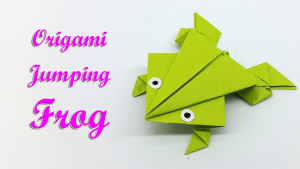
Origami is a fantastic craft activity for preschoolers to develop their fine motor skills and follow sequential instructions. Teach the children how to make jumping frogs with origami paper. Start with a square sheet of green paper and guide them through the folding process to create a frog shape. The folded paper frog can be pressed down on a flat surface and released to make it jump. Encourage the children to decorate their origami frogs with eyes, a mouth, and patterns using markers or colored pencils. This activity not only promotes dexterity but also introduces them to the art of origami.
Frog Bean Bag Toss:

Combine crafting and gross motor skills with a frog bean bag toss game. Provide each child with a green paper plate and help them transform it into a frog face by adding eyes, a mouth, and other features using colored paper, foam shapes, or markers. Cut out a large opening near the frog’s mouth to create a target. Next, set up buckets or containers of various sizes at different distances and assign point values to each one. The preschoolers can take turns tossing bean bags or crumpled balls of paper into the frog’s mouth, aiming for the different targets. This interactive craft game enhances hand-eye coordination and encourages friendly competition among the children.
Frog Finger Puppets:

Preschoolers can bring their froggy friends to life with adorable frog finger puppets. Provide each child with a green felt or construction paper and help them trace and cut out a frog shape. They can then decorate the frog with googly eyes, a mouth, and other details using markers, colored paper, or craft foam. Assist them in folding the bottom of the frog shape to create a pocket that fits onto their finger. The preschoolers can slide their fingers inside the puppets and use their newfound friends for storytelling, imaginative play, or even a puppet show.
Frog Toss Game:

Preschoolers can practice their aiming and throwing skills with a fun frog toss game. Set up a lily pad-shaped target using a large poster board or construction paper. Decorate the target with various point values or colors. Provide the children with bean bags or softballs and have them take turns tossing them onto the lily pad target. Encourage them to aim for specific areas to earn more points. The child with the highest score can be declared the “frog-tossing champion.” This game promotes hand-eye coordination, counting skills, and friendly competition.
Frog Suncatchers:

Preschoolers can create vibrant frog suncatchers to brighten up any window or classroom. Provide each child with a plastic or paper plate and help them cut out the center to create a ring shape. Instruct them to decorate the ring using green tissue paper or colored cellophane, gluing the pieces onto the plate. They can add eyes, a mouth, and other frog features using construction paper or markers. Once the decorations are complete, attach a string or ribbon to hang the suncatchers near a window. As sunlight shines through the colorful materials, the frog suncatchers will create a beautiful display of colors and patterns.
Frog Race Track:

Preschoolers can engage in a lively and interactive frog race with a homemade frog race track. Create a track using a long strip of green felt or construction paper. Decorate the track with various obstacles and features like ponds, lily pads, or rocks. Provide each child with a small toy frog or a cutout frog shape and let them place their frogs at the starting line. The children can take turns rolling a die or spinning a spinner to determine how many steps their frog can move forward. The first frog to reach the finish line is the winner. This game promotes counting, taking turns, and gross motor skills.
Frog Memory Game:

Preschoolers can sharpen their memory and concentration skills with a frog-themed memory game. Create pairs of frog pictures by printing or drawing multiple copies of different frog images. Place the cards face down in a grid formation. The children can take turns flipping over two cards, trying to match the pairs. If they find a matching pair, they keep the cards and get another turn. If the cards do not match, they are flipped back over, and the next player takes a turn. The game continues until all the cards are matched. This activity enhances cognitive skills, visual memory, and focus.
Frog Headband:

Preschoolers can become frogs themselves by making adorable frog headbands. Provide each child with a green strip of construction paper or cardstock long enough to fit around their heads comfortably. Help them decorate the strip with frog eyes, a mouth, and other frog features using markers, colored paper, or craft foam. They can also add additional decorations like paper cutout flies or lily pads. Once the headbands are decorated, secure the ends together with tape or staples to create a loop. The preschoolers can wear their frog headbands during pretend play, frog-themed activities, or a lively frog parade.
Frog Collage:

Preschoolers can explore their artistic skills and create unique frog collages using a variety of materials. Provide each child with a sheet of paper or cardstock and a collection of materials such as colored paper, tissue paper, fabric scraps, buttons, sequins, and feathers. Instruct them to cut out or tear different shapes and pieces from the materials to assemble their frogs on the paper. They can use the materials to create the frog’s body, eyes, legs, and other details. Encourage them to experiment with different textures, colors, and patterns. The resulting collages will showcase their creativity and provide a wonderful opportunity for self-expression.
Frog Mosaic Art:
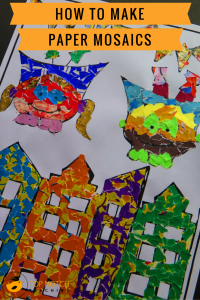
Preschoolers can create stunning mosaic art using small, colored pieces of paper. Provide each child with a frog-shaped template or a blank sheet of paper to create their own frog shape. Instruct them to tear or cut small squares or shapes from different colored paper. They can then glue the paper pieces onto their frog template, filling it with a mosaic of colors. Encourage them to mix and match the colors to create patterns or designs on their frogs. The mosaic art activity promotes fine motor skills, color recognition, and creative expression.
Frog Balloon Painting:
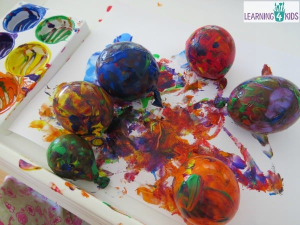
Preschoolers can have a blast creating unique frog paintings using balloons as their artistic tools. Set up a painting station by covering tables with protective materials and providing each child with a sheet of paper or canvas. Fill balloons with green paint and secure the openings with a knot. Instruct the children to dip the balloons into the paint and then press them onto their paper to create frog-shaped prints. They can experiment with different pressures, angles, and balloon sizes to create various effects. Once the prints are dry, they can add additional details like eyes, a mouth, and legs using markers or paintbrushes. This activity allows children to explore different painting techniques while creating their own frog masterpieces.
Frog Story Stones:

Preschoolers can engage in imaginative storytelling with frog story stones. Collect smooth, flat stones of various sizes and colors. Help the children paint the stones green, representing frogs. Once the paint is dry, provide them with markers or paint pens to draw eyes, a mouth, and other frog features on the stones. They can also use additional colors to decorate the stones with patterns or designs. Once the story stones are ready, encourage the children to use them to create their own frog-themed stories. They can take turns selecting stones and incorporating the characters and elements into their imaginative narratives. This activity fosters language skills, creativity, and storytelling abilities.
